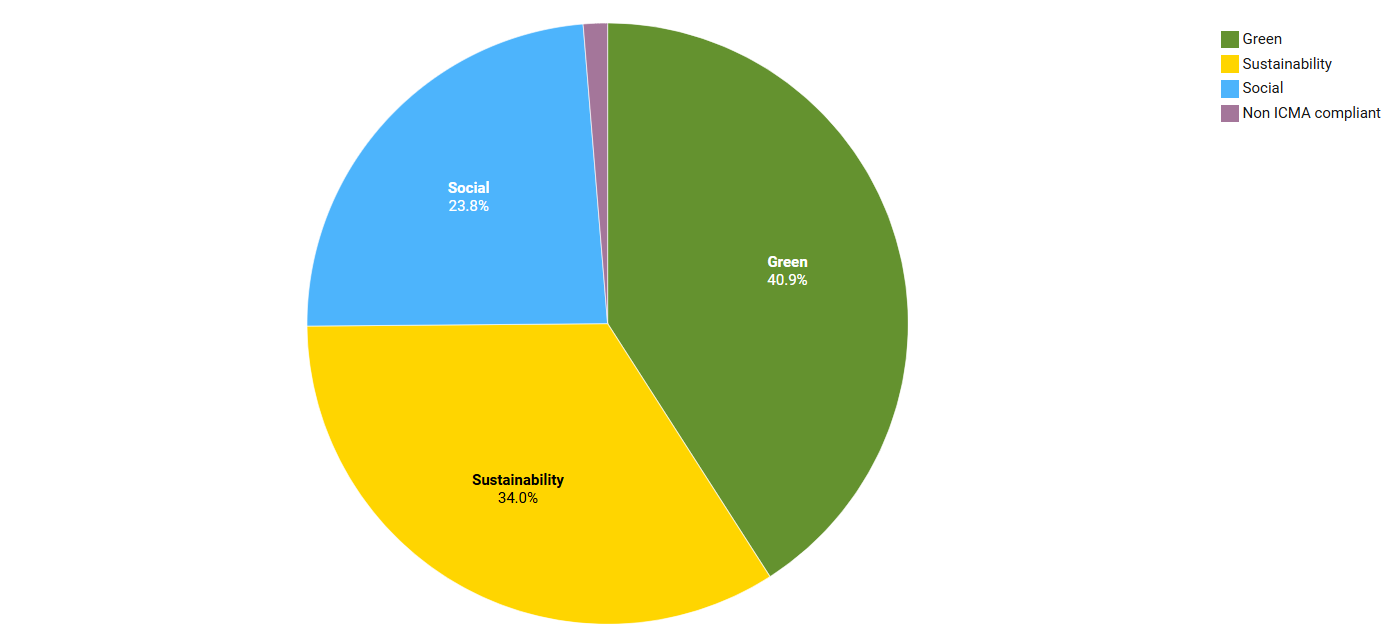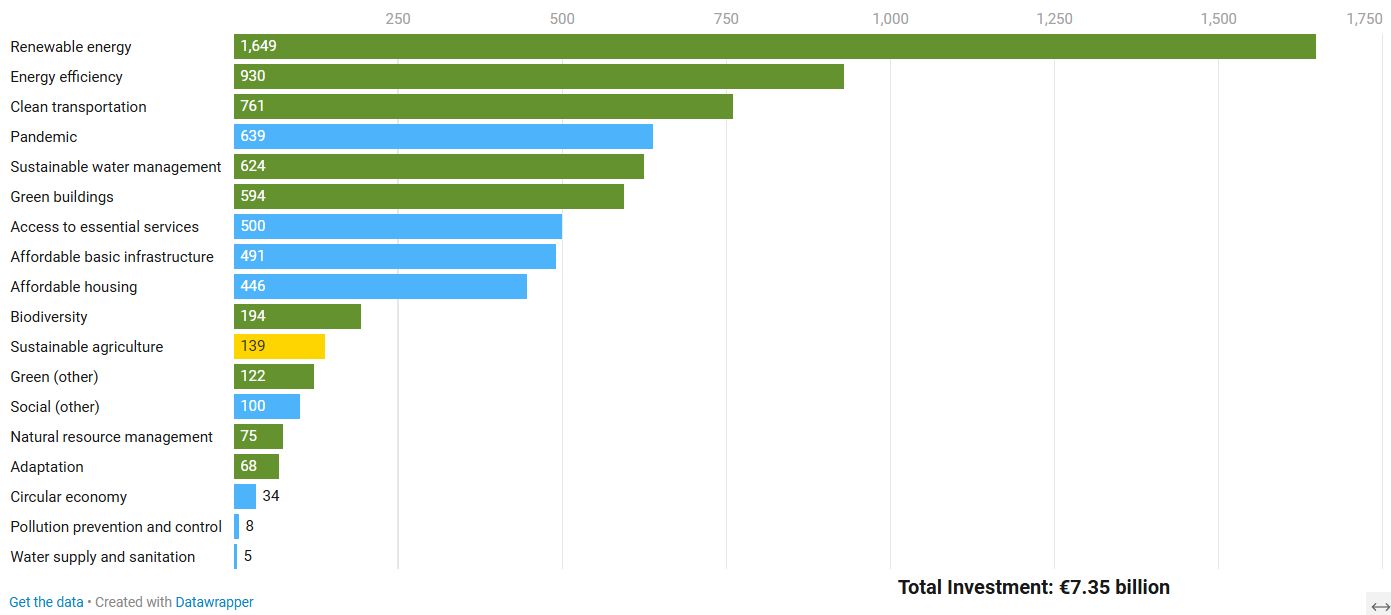Impact investing at ESM: the tangible effect of ESG labelled bonds
European Stability Mechanism (ESM) investments in environmental, social, and governance (ESG) labelled bonds reached €7.4 billion by the end of 2024. This significant allocation of its €80.5 billion paid-in capital underscores the ESM’s commitment to supporting this asset class and the specific objectives to which the proceeds are dedicated. The ESM has long recognised that the value of ESG-labelled bonds lies not just in their labels – green, social, or sustainability – but more precisely in the underlying projects they finance and, ultimately, their tangible impact. This is why subcategories of ESG labelled bonds become essential for responsible investors, allowing them to identify in which themes – from energy transition to biodiversity – investments are made. Consequently, issuers in labelled bonds provide increasingly more detailed expected allocations of the funds they raise. This blog explores how the sub-categorisation of use-of-proceeds bonds can help investors understand their impact and, consequently, how the ESM’s approach as an investor promotes sustainable prosperity.
Understanding ESG use-of-proceeds bonds: beyond the label, why subcategory themes matter
ESG use-of-proceeds bonds, which is the technical term for sustainable bonds or ESG bonds, are debt instruments whose funds raised are earmarked for specific projects with clear sustainability objectives. These bonds are typically aligned with international standards, the International Capital Market Association (ICMA) principles being the most commonly used, ensuring transparency and accountability in how proceeds are allocated and that capital is used for measurable environmental or social benefits. By monitoring the subcategories where projects apply the proceeds, investors can better understand what is being financed and what outcomes are expected.
Green bond subcategories typically include projects focused on renewable energy, energy efficiency, clean transportation, sustainable water management, or biodiversity conservation. Social bonds include subcategories such as affordable housing or infrastructure, access to essential services, and healthcare support (most notably following the Covid-19 pandemic). Sustainability bonds, in turn, include a combination of both, financing projects that deliver co-benefits across environmental and social dimensions.
European leadership key for ESG bond market evolution
With nearly USD 900 billion issued in 2024 adding to the overall global issuance of nearly USD 4.8 trillion,[1] the sustainable bond market has matured considerably. Europe has continued to lead in both volume and innovation, with nearly 48% of global sustainable bonds issued in euros and a 46% share of the market being issued in Europe (excluding supranational issuers). Furthermore, with the European Union (EU) initiatives of a common taxonomy for sustainable economic activities and the Corporate Sustainability Reporting Directive gaining traction to provide additional transparency to market participants, investors will be able to better assess not just what is financed but also how it contributes to overall sustainability goals. In this context, the newly introduced European Green Bond Standard, based on the EU taxonomy, will set the gold standard for transparency and alignment for green bonds, further strengthening investor confidence.
ESM investment in ESG bonds: from labels to impact
By analysing and monitoring the reports published by ESG bond issuers, the ESM and other investors can evaluate the types of projects they are financing. By the end of 2024, the ESM had invested €7.4 billion of its paid-in capital in use-of-proceeds bonds, split as 40.9% in green bonds, 23.8% in social bonds, and 34.0% in sustainability bonds.
Figure 1: Split of investments in ESG bonds by ESM paid-in capital, December 2024.

Sources: Issuers’ reported data, ESM calculations. “Non-ICMA compliant” ESG bonds refers to bonds purporting to address environmental, social, or governance objectives but issued without alignment to the voluntary international standards defined by the International Capital Market Association (ICMA).
These bonds provide competitive liquidity and return – with some green bonds even trading at a premium (‘greenium’) compared to conventional bonds, reflecting investor willingness to receive a slightly lower yield in support of sustainability objectives – while also enabling investors to observe the tangible impact of their investments. The ESM therefore examines the subcategories across its ESG-labelled bond holdings to better understand the environmental and social outcomes of its investments.
Based on issuers’ disclosures of how proceeds were allocated across ESG subcategories, it was estimated that out of the €7.4 billion ESM invested in ESG labelled bonds, €1.65 billion (22%) financed renewable energy projects, €930 million (12.6%) financed energy efficiency projects, and €761 million (10.3%) financed clean transportation projects. In addition, more than €2 billion (32%) was directed toward social projects, including pandemic support, access to essential services, affordable basic infrastructure, and affordable housing.
Figure 2: Allocation by sub-categories of ESG bond investments by ESM paid-in capital(in € million), December 2024.


Sources: Issuers’ reported data, ESM calculations
This detailed overview is quite unique. The ESM analysed over 100 bond investments, issued by sovereigns, multilateral development banks, and government agencies. For each, the impact reports and classifications were reviewed. This data-driven approach allows the ESM to closely analyse the impact of its investments, using the subcategories to gain a more detailed picture of capital allocation to projects and to serve as a tool to measure impact. Investing in ESG bonds is not only compatible with prudent financial management but also essential for fostering the long-term prosperity and resilience of Europe.
The ESM has identified climate adaptation, alongside demographics and geopolitics, as one of the three megatrends that will affect financial stability for future generations. Accordingly, the main allocations were to renewable energy, energy efficiency, and clean transportation (over €3 billion in total), which matches well with the large transition financing needs in Europe and worldwide. This helps support the build-up of more future-proof and resilient economies.
The other major themes of access to essential services, basic infrastructure, and affordable housing (which attracted €1.5 billion of the proceeds), fit with the ESM’s social dimension and the aim to deliver better services for citizens. The environmentally focused categories of sustainable water management, biodiversity, natural resource management, and pollution prevention and control (representing close to €1 billion of ESM labelled bond proceeds) support future generations in Europe and beyond.
Conclusion
As the rapid evolution of the ESG bond market has reshaped sustainable investment globally, demand for sustainable assets has intensified in the last decade and, necessarily, also the need to diversify and expand ESG-labelled bond holdings (now a cornerstone for many fixed-income responsible investment strategies).
As the ESG bond market continues to innovate and expand, the ESM aims to continue investing responsibly while engaging with credible standards and supporting the transition to a more sustainable and inclusive economy.
ESG investments align closely with both the ESM’s investment strategy and its mandate to safeguard financial stability for future generations. They not only complement our core investment objectives but also help societies tackle some of the most pressing challenges of our time.
Acknowledgements
The authors would like to thank Sebastien Levy for his valuable suggestions and contributions to this blog post, as well as Raquel Calero and Karol Siskind for the editorial review.
Footnotes
About the ESM blog: The blog is a forum for the views of the European Stability Mechanism (ESM) staff and officials on economic, financial and policy issues of the day. The views expressed are those of the author(s) and do not necessarily represent the views of the ESM and its Board of Governors, Board of Directors or the Management Board.
Authors


Blog manager
